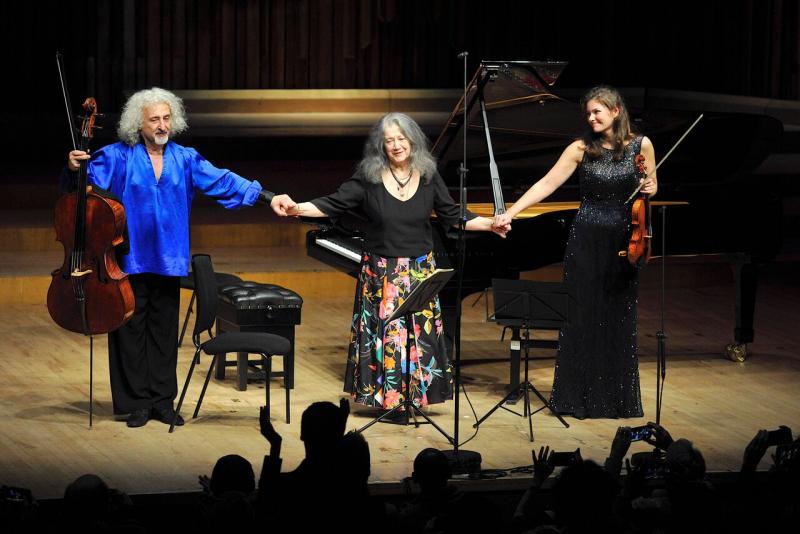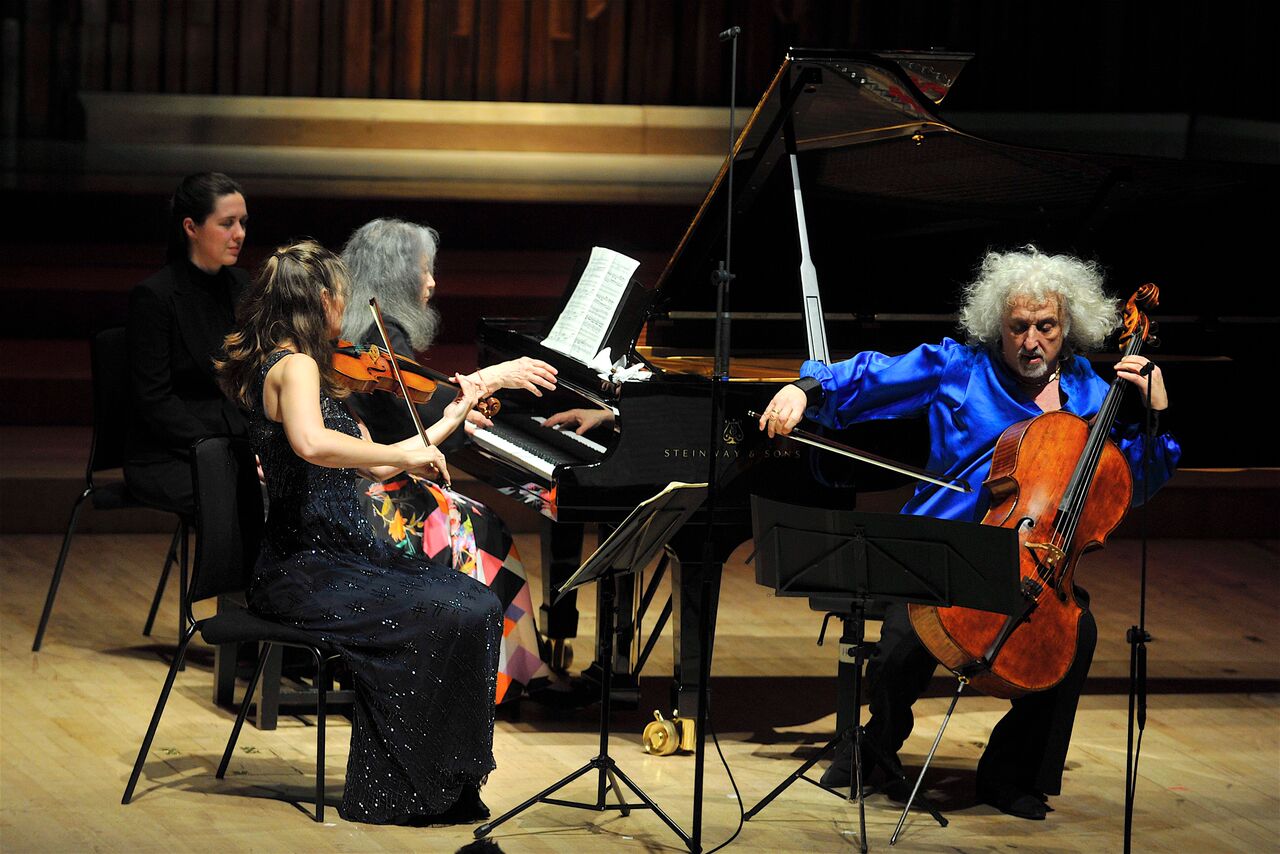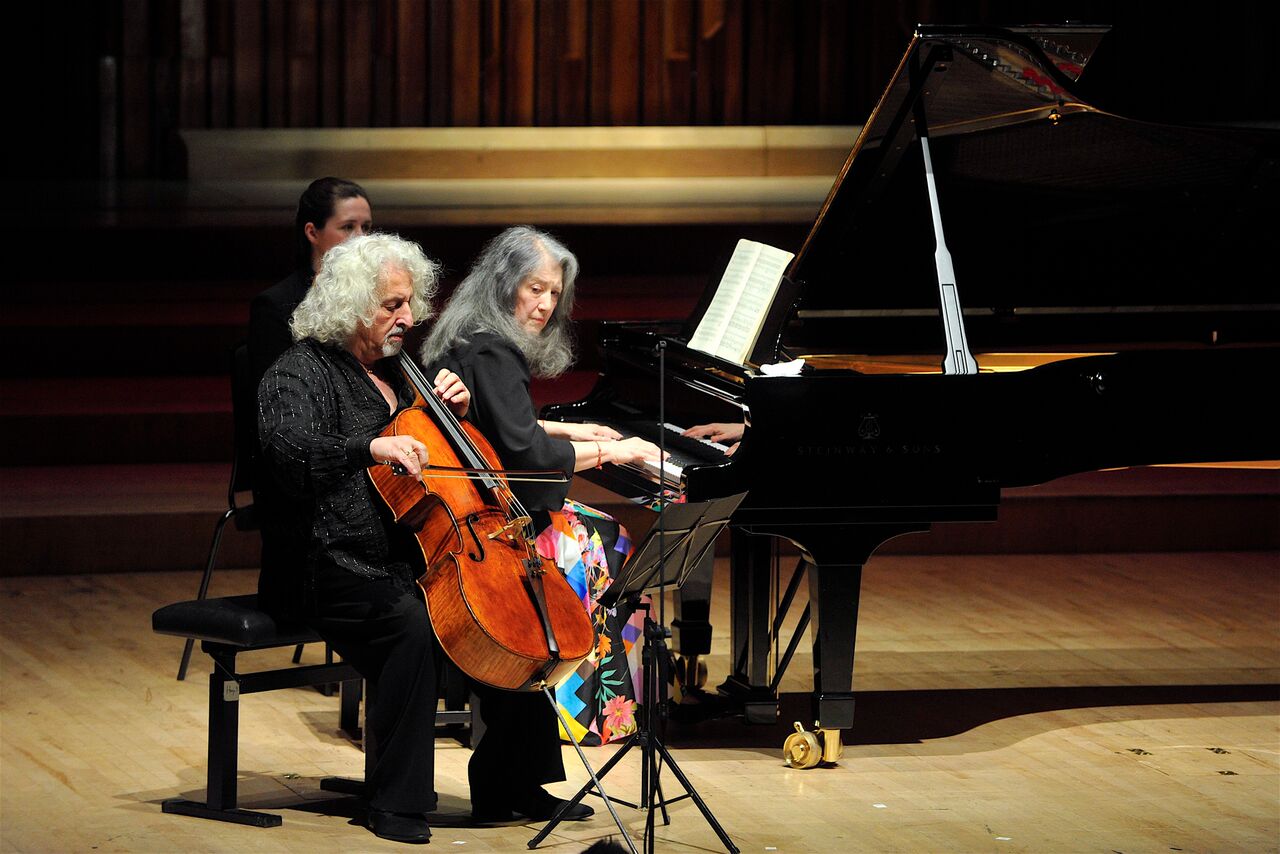Jansen/Maisky/Argerich Trio, Barbican review - three classical titans give chamber music masterclass | reviews, news & interviews
Jansen/Maisky/Argerich Trio, Barbican review - three classical titans give chamber music masterclass
Jansen/Maisky/Argerich Trio, Barbican review - three classical titans give chamber music masterclass
Musical personalities shift but Argerich's generous musicianship remains the constant

They were billed as a Trio, but when the classical super-group of Janine Jansen, Mischa Maisky and Martha Argerich came together at the Barbican last night it was in a sequence of different combinations, each with their own musical identity. The centre of gravity, however, remained constant.
The alchemy of music-making is a funny thing. Decades of friendship and collaboration connect Argerich and Maisky, and yet musically they are completely different beasts. Argerich’s flames burn white-cool and close, while Maisky’s lick and sprawl with profligate, generous heat, sending sparks tumbling each time he draws his bow. It’s a contrast that flourished in Mendelssohn’s impetuous Trio No. 1 in D minor, and found common ground in Shostakovich’s Piano Trio No. 2 in E minor, but which contested the territory of the Beethoven.  The Cello Sonata No. 2 in G minor is a work in the grip of an identity crisis, trying on everything from JC Bach to Mozart to proto-Lisztian excess for size. While Maisky (pictured below with Argerich), responsive to these mercurial moods, whittled down his broad tone right down to a soft classical point for the opening, drawing thicker and harder into the tempestuous Allegro, Argerich had the Romantic drama in her sights from the start, tugging the music forwards in time even a Maisky pulled it back.
The Cello Sonata No. 2 in G minor is a work in the grip of an identity crisis, trying on everything from JC Bach to Mozart to proto-Lisztian excess for size. While Maisky (pictured below with Argerich), responsive to these mercurial moods, whittled down his broad tone right down to a soft classical point for the opening, drawing thicker and harder into the tempestuous Allegro, Argerich had the Romantic drama in her sights from the start, tugging the music forwards in time even a Maisky pulled it back.
The Jansen-Argerich partnership, by contrast, feels like a natural, instinctive kinship. In addition to their astonishing technical facility both share a musical courage of conviction – a willingness to do less, to let the audience hear straight through to the composer without mediation. The apparently unworked directness that results is as exhilarating as it is disarming, and Schumann's A minor sonata unfolded in a single, unbroken thought, led by Jansen’s sweet-strong violin.
It’s hard to imagine two more contrasting trios than the exuberant affirmation and celebration of the Mendelssohn and the trauma and rage of the Shostakovich. The Mendelssohn – a thrilling closer – saw Argerich step forward to set the pace, laying a frenetic musical paper trail in the Scherzo for violin and cello to follow – its bustling, characterful quality a world away from the opaque clarity and control of the passagework in both the outer movements, semiquavers scattered like diamonds, catching the eye beneath the heavy velvet of Maisky and Jansen.  But it was the Shostakovich that haunts. The icy cello harmonics and resigned, canonic tread of the opening can set it up for numbed suppression – emotion felt, but buried fathoms deep. Here, in the defiant urgency of the dances, the manipulation of intonation as a colour, the insistence on individual voice and identity from Jansen and Maisky, we had something else.
But it was the Shostakovich that haunts. The icy cello harmonics and resigned, canonic tread of the opening can set it up for numbed suppression – emotion felt, but buried fathoms deep. Here, in the defiant urgency of the dances, the manipulation of intonation as a colour, the insistence on individual voice and identity from Jansen and Maisky, we had something else.
Music here might lose its fight for life – sound subsiding into not just harmonics but pizzicato shards and finally col legno husk – but there’s a wonderful tension that comes from a performance that won’t accept that, that refuses to go gently. It’s hope, not horror, that gets you in the end, as Argerich, Maisky and Jansen, dogged in their search of resolution, redemption, understood so completely.
rating
Explore topics
Share this article
The future of Arts Journalism
You can stop theartsdesk.com closing!
We urgently need financing to survive. Our fundraising drive has thus far raised £49,000 but we need to reach £100,000 or we will be forced to close. Please contribute here: https://gofund.me/c3f6033d
And if you can forward this information to anyone who might assist, we’d be grateful.

Subscribe to theartsdesk.com
Thank you for continuing to read our work on theartsdesk.com. For unlimited access to every article in its entirety, including our archive of more than 15,000 pieces, we're asking for £5 per month or £40 per year. We feel it's a very good deal, and hope you do too.
To take a subscription now simply click here.
And if you're looking for that extra gift for a friend or family member, why not treat them to a theartsdesk.com gift subscription?
more Classical music
 BBC Proms: Barruk, Norwegian Chamber Orchestra, Kuusisto review - vague incantations, precise laments
First-half mix of Sámi songs and string things falters, but Shostakovich scours the soul
BBC Proms: Barruk, Norwegian Chamber Orchestra, Kuusisto review - vague incantations, precise laments
First-half mix of Sámi songs and string things falters, but Shostakovich scours the soul
 BBC Proms: Alexander’s Feast, Irish Baroque Orchestra, Whelan review - rapturous Handel fills the space
Pure joy, with a touch of introspection, from a great ensemble and three superb soloists
BBC Proms: Alexander’s Feast, Irish Baroque Orchestra, Whelan review - rapturous Handel fills the space
Pure joy, with a touch of introspection, from a great ensemble and three superb soloists
 BBC Proms: Moore, LSO, Bancroft review - the freshness of morning wind and brass
English concert band music...and an outlier
BBC Proms: Moore, LSO, Bancroft review - the freshness of morning wind and brass
English concert band music...and an outlier
 Willis-Sørensen, Ukrainian Freedom Orchestra, Wilson, Cadogan Hall review - romantic resilience
Passion, and polish, from Kyiv's musical warriors
Willis-Sørensen, Ukrainian Freedom Orchestra, Wilson, Cadogan Hall review - romantic resilience
Passion, and polish, from Kyiv's musical warriors
 BBC Proms: Faust, Gewandhausorchester Leipzig, Nelsons review - grace, then grandeur
A great fiddler lightens a dense orchestral palette
BBC Proms: Faust, Gewandhausorchester Leipzig, Nelsons review - grace, then grandeur
A great fiddler lightens a dense orchestral palette
 BBC Proms: Jansen, Royal Concertgebouw Orchestra, Mäkelä review - confirming a phenomenon
Second Prom of a great orchestra and chief conductor in waiting never puts a foot wrong
BBC Proms: Jansen, Royal Concertgebouw Orchestra, Mäkelä review - confirming a phenomenon
Second Prom of a great orchestra and chief conductor in waiting never puts a foot wrong
 BBC Proms: Royal Concertgebouw Orchestra, Mäkelä review - defiantly introverted Mahler 5 gives food for thought
Chief Conductor in Waiting has supple, nuanced chemistry with a great orchestra
BBC Proms: Royal Concertgebouw Orchestra, Mäkelä review - defiantly introverted Mahler 5 gives food for thought
Chief Conductor in Waiting has supple, nuanced chemistry with a great orchestra
 Dunedin Consort, Butt / D’Angelo, Muñoz, Edinburgh International Festival 2025 review - tedious Handel, directionless song recital
Ho-hum 'comic' cantata, and a song recital needing more than a beautiful voice
Dunedin Consort, Butt / D’Angelo, Muñoz, Edinburgh International Festival 2025 review - tedious Handel, directionless song recital
Ho-hum 'comic' cantata, and a song recital needing more than a beautiful voice
 Classical CDs: Dungeons, microtones and psychic distress
This year's big anniversary celebrated with a pair of boxes, plus clarinets, pianos and sacred music
Classical CDs: Dungeons, microtones and psychic distress
This year's big anniversary celebrated with a pair of boxes, plus clarinets, pianos and sacred music
 BBC Proms: Liu, Philharmonia, Rouvali review - fine-tuned Tchaikovsky epic
Sounds perfectly finessed in a colourful cornucopia
BBC Proms: Liu, Philharmonia, Rouvali review - fine-tuned Tchaikovsky epic
Sounds perfectly finessed in a colourful cornucopia
 BBC Proms: Suor Angelica, LSO, Pappano review - earthly passion, heavenly grief
A Sister to remember blesses Puccini's convent tragedy
BBC Proms: Suor Angelica, LSO, Pappano review - earthly passion, heavenly grief
A Sister to remember blesses Puccini's convent tragedy
 BBC Proms: A Mass of Life, BBCSO, Elder review - a subtle guide to Delius's Nietzschean masterpiece
Mark Elder held back from blasting the audience with a wall of sound
BBC Proms: A Mass of Life, BBCSO, Elder review - a subtle guide to Delius's Nietzschean masterpiece
Mark Elder held back from blasting the audience with a wall of sound

Add comment